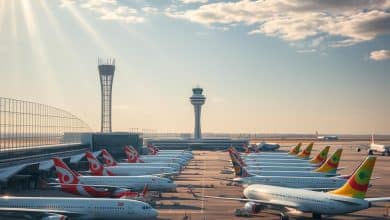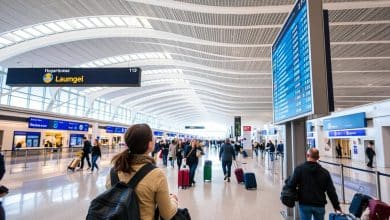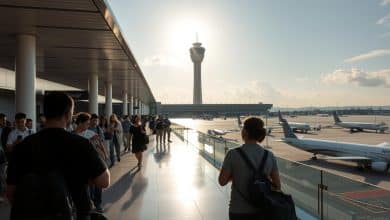Italy Flight Tips: Budget Carrier Hubs & Rail-and-Fly Benefits
Planning a journey to this beloved European destination requires smart strategies.
Many travelers seek ways to make their vacation budget stretch further. This guide offers essential advice for navigating air travel options effectively.
Understanding where budget airlines operate from can lead to significant savings. These carriers often use specific airports, which might be different from major international hubs. Knowing these locations opens up more affordable fare options.
Another powerful method involves combining plane tickets with train travel. Italy’s extensive rail network connects major cities efficiently. This rail-and-fly approach creates a seamless and flexible itinerary for exploring different regions.
This article explores these practical methods in detail. Readers will learn how to find the best deals and simplify their transportation logistics. The goal is a smoother, more enjoyable start to an Italian adventure.
Introduction: Embracing La Dolce Vita in Italy
For countless travelers, a visit to this nation represents a lifelong dream. It stands as a premier global destination, captivating visitors with its stunning landscapes and rich cultural tapestry. The country holds some of the world’s greatest artistic and historical treasures.
Many visitors spend extended periods, sometimes half a year or more, living like temporary locals. They seek to absorb the authentic Italian approach to living fully. This philosophy, known as la dolce vita or “the sweet life,” emphasizes savoring everyday moments.
The true experience goes beyond famous landmarks. It includes discovering hidden neighborhood trattorias and watching skilled artisans at work. Understanding local customs, from meal times to dress codes, deepens the journey.
This guide simplifies the travel process. It helps visitors focus their energy on immersion rather than logistics. Mastering transportation fundamentals allows for a richer, more memorable experience.
Understanding Italy Flight Tips and Travel Planning
A successful journey begins long before departure, rooted in thoughtful preparation. This initial stage focuses on aligning dreams with practical realities. Effective organization prevents costly mistakes and stressful situations.
Setting Your Travel Goals
Travelers should first define what they hope to achieve. Is the focus on art, food, relaxation, or a blend? Clear objectives help shape the entire plan.
They must consider the seasonality of desired activities. Many tours and attractions operate on specific schedules. Researching availability for must-see events dictates optimal travel dates.
This research influences time-off requests and booking timelines. Securing spots for popular experiences often requires advance action.
Budgeting and Time Management
A comprehensive budget looks beyond the main plane ticket. It includes internal travel, airport transfers, and potential pre-flight accommodations. This holistic view protects funds for memorable experiences.
Smart time management involves creating realistic daily schedules. Overpacking an itinerary leads to exhaustion. Balancing major sights with downtime allows for spontaneous discovery.
Savings from strategic bookings free up money for enrichment. Consider these rewarding options:
- Small-group food tours in historic neighborhoods
- Wine tastings at family-run vineyards
- Hands-on cooking classes with local chefs
- Extended stays at countryside agriturismos
This approach ensures resources like time and money enhance the overall adventure.
Budget Carrier Hubs in Italy
Smart travelers know that airport choice is as important as airline selection. While major international gateways like Rome Fiumicino and Milan Malpensa handle numerous flights, budget airlines often favor secondary airports.
These alternative hubs, such as Rome Ciampino and Milan Bergamo, can offer substantially lower fares. Understanding this network is key to finding the best routing options between major cities.
Top Budget Airlines to Consider
Several carriers dominate the low-cost market across the country. They provide numerous options for both international arrivals and domestic connections.
- Ryanair: Has an extensive network from airports like Bergamo and Treviso.
- EasyJet: Often uses primary hubs but still offers competitive prices.
- Wizz Air: Connects various Italian destinations with Eastern Europe.
Travelers must read the fine print. Booking separate tickets on different airlines means connections are not guaranteed. A missed leg can cost extra money and negate any initial savings.
Finding Last-Minute Flight Deals
While last-minute deals do appear, they are a risky strategy. Airlines may slash prices to fill seats, but this is rare during peak seasons.
Demand often exceeds supply on popular routes. Relying on a spontaneous deal can lead to limited options and higher costs. It is generally wiser to book in advance for peace of mind.
Always calculate the total cost, including fees for bags and seat selection. This ensures the budget option truly saves money.
Rail-and-Fly Options: Seamless Connections
Combining air and rail travel unlocks a uniquely efficient way to explore the country’s diverse regions. This integrated approach often proves faster and more economical than relying solely on planes for internal travel.
It connects major international airports directly with city centers and smaller towns. This creates a smooth transition from a long-haul journey to local exploration.
Benefits of Rail-And-Fly Tickets
Many airlines partner with rail services to offer combined tickets. This simplifies the booking process into a single transaction.
Passengers can often check their luggage straight through to their final train station destination. This eliminates the hassle of managing bags during transfers.
High-speed Frecciarossa trains are a key advantage. They connect cities like Milan, Florence, and Rome in hours, rivaling air travel time when airport logistics are considered.
Strategies for Booking Train Transfers
Planning ahead is crucial for securing the best fares. Advance purchases for point-to-point train tickets can lead to significant savings.
Consider these smart strategies when organizing your journey:
- Book train tickets online well in advance for the lowest prices.
- Allow ample buffer time between your flight arrival and train departure.
- Understand ticket validation rules to avoid fines for paper tickets.
- Use a budget flight to a major hub, then take trains to smaller destinations.
This method provides incredible flexibility and scenic views missed from the air. It is a fantastic way to enhance the experience of traveling Italy.
Timing is Everything: Booking Your Flights Early
Securing the best airfare often comes down to one crucial element: timing. Purchasing tickets well in advance typically unlocks the lowest prices before demand causes costs to rise. This is especially true for travel during popular seasons.
Strategic planning involves booking at least six months ahead for peak periods. This provides access to the most competitive fares. Last-minute opportunities are rare and come with significant risk.
Early Bird Deals and Price Alerts
Technology offers a powerful advantage for savvy travelers. Tools like Google Flights allow users to set up price alerts for specific routes. These alerts notify them immediately when fares drop, taking the guesswork out of the process.
Understanding pricing patterns is also key. Costs generally increase as the departure day approaches. Travelers should make sure to consider the time of week they fly.
- Weekday flights, especially midweek, are often cheaper than weekend options.
- Fridays and Sundays see higher demand from both business and leisure travelers.
- Coordinating airfare purchases with other bookings, like popular tours, ensures date alignment.
This proactive approach saves money and reduces stress. It allows travelers to focus their energy on the exciting parts of their journey.
Navigating Italy’s Airport Logistics
Mastering airport logistics upon arrival sets the tone for a smooth and enjoyable journey throughout the destination. Understanding the layout and transportation options before landing eliminates confusion.
Most international visitors arrive at Rome Fiumicino or Milan Malpensa airports. These major hubs offer excellent connections to other cities across the country.
Planning airport-to-city transfers in advance saves time and money. Train service often provides the fastest way to reach central urban areas.
Many urban centers around airports have restricted traffic zones called ZTL. Unauthorized vehicles face substantial fines in these protected places.
Non-EU visitors need an international driving permit for car rentals. This document must be obtained before departure through organizations like AAA.
Smaller regional airports serve specific destinations conveniently. Venice, Florence, Naples, and Catania have their own facilities.
Understanding arrival procedures streamlines the initial travel experience. This includes baggage claim, customs, and obtaining local SIM cards.
Cultural Norms and Daily Closures in Italy
Understanding local customs and business hours can transform a tourist’s experience from frustrating to fulfilling. Adapting to the rhythm of daily life prevents common misunderstandings that disrupt travel plans.
Visitors should align their schedules with traditional patterns. This approach respects local culture while ensuring access to desired attractions.
Lunch and Sunday Closures Explained
Many businesses observe afternoon closures during the hottest part of the day. This tradition reflects historical adaptation to Mediterranean climate conditions.
Sunday remains a family-focused day throughout the country. People typically gather at home for extended meals rather than patronizing commercial establishments.
Restaurants follow distinct operating patterns. Most close between lunch and dinner service, reopening around 7:00 or 7:30 PM.
Regional differences affect dining times. Southern areas typically eat later in the evening than northern regions.
August presents particular challenges for visitors. Intense heat combines with widespread closures as locals take traditional summer holidays.
Even major museums may operate on reduced schedules. Some places open for only half days on certain days of the week.
Advance research ensures access to specific attractions. Planning one or two major activities per day accommodates closure schedules effectively.
Staying Safe: Security and Scam Prevention
Travelers can enhance their personal security with simple, proactive measures. While the country maintains a low violent crime rate, visitors should remain vigilant in crowded urban centers. Petty theft represents the most common concern for international guests.
Professional pickpockets often operate in popular tourist areas and on public transportation. They target distracted individuals who are focused on sightseeing. Effective prevention starts with securing valuables in a practical way.
Practical Theft Prevention
Using a cross-body bag worn to the front provides excellent protection. Keeping zippers closed and maintaining hand contact adds another layer of security. Men should store wallets in front pockets rather than back pockets.
Many travelers find hidden money belts ideal for passports and extra cash. This distribution method ensures that a single theft doesn’t leave people without resources. Solo female travelers can explore safely by researching neighborhoods and dressing modestly.
Common scams involve aggressive vendors offering “free” bracelets or petitions. Understanding these patterns helps tourists recognize and avoid problematic situations. A firm “no” and walking away is the best response to unsolicited approaches.
Insider Public Transportation Tips in Italy
Navigating public transportation like a local transforms the travel experience from touristy to authentic. Mastering these systems unlocks affordable mobility throughout the country. Visitors can move between urban centers with confidence and efficiency.
Using Local Apps and Tools
Digital tools simplify getting around any city. WhatsApp serves as the primary communication platform for many residents and businesses. Travelers can use it for free calls and texts over wifi.
Local transit apps provide real-time schedules and route planning. They help navigate bus, tram, and metro systems efficiently. Building extra time into itineraries accounts for occasional delays.
Checking official strike schedules before travel days allows for contingency planning. This realistic approach prevents stress when buses or trains run behind schedule.
Validation and Ticketing Best Practices
Understanding ticket validation prevents costly fines. Paper tickets without assigned seats require stamping before boarding. Validation machines at stations activate tickets with date and time.
Online purchases with seat assignments typically need no validation. Authorities regularly check for properly stamped tickets during travel. Following these rules ensures smooth journeys on trains and buses.
Expert Italy flight tips for Budget and Time Savings
Digital tools and insider knowledge combine to create powerful savings opportunities for international journeys. Expert travelers employ specific strategies that consistently deliver better prices and more convenient routing options.
Google Flights stands out as a comprehensive search tool for this planning. It offers visual calendar displays showing price variations across different dates. The platform also provides flexible date searches and price tracking features.
Browsing in incognito mode can sometimes help find cheaper fares. This technique prevents airlines and booking sites from tracking search history. The effectiveness varies, but it’s worth trying during the search process.
Booking directly with airlines often provides better customer service and easier changes. Third-party aggregators sometimes miss flights visible only on airline websites. Direct booking ensures access to all available options.
When planning connections with different carriers, travelers must allow sufficient time between flights. Separate bookings carry no guaranteed connections. Missed flights become the passenger’s responsibility without this buffer.
Strategic travelers compare total trip costs rather than just headline airfares. Low-cost carriers often charge substantial fees for additional services. Building airline relationships through frequent flyer programs can enhance comfort and flexibility.
Food and Dining Tips: Eating Like a Local
Food customs reveal much about a destination’s character and social rhythms. Understanding local dining etiquette transforms meals from simple nourishment to authentic cultural experiences. These practices connect travelers with centuries of culinary tradition.
Ordering Coffee and Navigating Meal Times
Italian coffee culture follows specific protocols. Locals typically drink espresso standing at the bar counter. Sitting at a table can triple the price of the same beverage.
Travelers should order cappuccino only before noon. After lunch, it’s considered a breakfast drink. Ordering “caffè latte” is correct—asking for just “latte” brings a glass of milk.
Restaurant etiquette differs significantly from North American norms. Diners must request the bill by saying “il conto, per favore.” Servers won’t bring it automatically.
Most bills include a coperto charge per person. This covers bread, water, and table service. Tipping is not expected since servers earn living wages.
The house wine often comes from local vineyards and is typically excellent. Bread serves to soak up pasta sauce after the meal, not as a pre-meal snack. Avoid asking for oil or vinegar.
Aperitivo culture offers pre-dinner drinks with complimentary snacks. This helps travelers adjust to late dining times. Following these food tips ensures authentic culinary experiences.
Packing Smart: Essential Items for an Italy Trip
A well-organized suitcase serves as the foundation for stress-free exploration throughout the journey. Strategic packing balances comfort with practical mobility considerations.
Creating a capsule wardrobe with coordinating pieces maximizes outfit options while minimizing luggage volume. Neutral colors and versatile layers accommodate various weather conditions. This approach proves especially useful when visiting multiple places during one trip.
Respectful dress requirements at religious sites mandate covered shoulders and knees. Packing lightweight scarves or cardigans ensures access to these important places without emergency purchases.
Essential travel accessories include European electrical adapters and voltage converters. Many accommodations use key-card-activated lighting systems for energy efficiency.
Bringing a refillable water bottle reduces expenses and environmental impact. Some cities offer fresh drinking water through public fountains, making refills convenient throughout the day.
Practical items often overlooked include personal washcloths and travel-size tissue packets. Comfortable walking shoes suitable for uneven surfaces rank among the most important things to pack.
Packing light becomes crucial when using public transportation systems. Limited luggage space on trains and hotels with narrow staircases make minimalist packing a smart strategy for any trip.
Immersive Experiences: Tours, Attractions, and Local Culture
Immersive experiences transform a standard vacation into a deep cultural connection. These tours and attractions create lasting memories through expert interpretation. They provide context that independent exploration often misses.
Exploring Small Group Tours
Small group tours offer exceptional value through local expertise. Knowledgeable guides reveal hidden details and historical context. They often include skip-the-line privileges at popular attractions.
Food and wine tours introduce regional specialties and preparation methods. Participants sample products from neighborhood markets and family bakeries. These culinary adventures create authentic experiences.
Advance booking ensures access to major sites during limited vacation time. Popular attractions like Vatican tours often sell out weeks ahead. Planning prevents disappointment at must-see locations.
Consider these rewarding options for deeper cultural connection:
- UNESCO World Heritage Sites – 53 locations across the country
- Free museum admission on the first Sunday of each month
- Church artworks displayed in their original commissioned locations
- Neighborhood walks discovering artisan workshops and scenic viewpoints
These experiences connect travelers with living traditions. They transform sightseeing into meaningful cultural exchange. A good guide can make any city feel like home.
Navigating Italy on Foot: Exploring the Heart of the Cities
Walking through historic districts reveals architectural details and neighborhood life that remain hidden from vehicle-bound visitors. This approach offers the most authentic way to experience urban centers at a human scale.
Comfortable, sturdy shoes prove essential for navigating uneven cobblestones and ancient staircases. These surfaces characterize many historic places throughout the country’s urban landscapes.
Choosing accommodations in central locations maximizes walking efficiency. Travelers can step directly from their lodging into the vibrant life of the city. This strategy reduces transportation dependence and increases exploration time.
Many iconic landmarks sit within pedestrian-only zones where vehicles cannot enter. Even visitors arriving by bus must complete their journey on foot. This requirement enhances rather than diminishes the overall experience.
Travelers with mobility challenges can use assistive devices like cane chairs. These tools provide stability on uneven surfaces and seating for rest breaks. Planning balanced itineraries ensures enjoyable exploration of these walking-focused cities.
The intimate scale of historic centers means most attractions lie within reasonable walking distance. Visitors can create efficient routes that flow naturally from one place to another. This allows for spontaneous discovery of hidden courtyards and artisan workshops along the way.
Utilizing Technology: Apps and Online Tools for Smooth Travel
Digital tools offer travelers unprecedented access to local knowledge and real-time information. Modern smartphone applications transform the entire journey experience. They provide capabilities that once required extensive research and local contacts.
WhatsApp serves as the primary communication platform throughout the country. Many businesses list their WhatsApp numbers for convenient service. This allows free calls and texts over wifi, making it easy to stay in touch with home.
Flight search tools like Google Flights provide comprehensive comparisons across airlines. They help identify the most cost-effective options for traveling italy. Using incognito browsing can sometimes reveal better deals.
Navigation apps designed for pedestrian travel offer superior guidance in historic centers. Translation tools assist with menus and basic conversations. Booking platforms enable advance ticket purchases that save valuable time.
These technological resources serve as an essential guide for modern explorers. They represent the best way to access practical travel tips. Smart use of apps ensures a smoother, more connected journey experience.
Conclusion
Transformative trips emerge from the delicate balance of advance research and on-the-ground flexibility. This guide has outlined strategies to help travelers navigate this beautiful destination efficiently while leaving room for authentic cultural discovery.
Securing travel insurance soon after making initial deposits provides crucial protection for your investment. Comparison websites offer this essential service without markup, delivering policies quickly. This practical step ensures peace of mind throughout your journey.
The most memorable experiences often unfold in local markets and family-run eateries showcasing regional cuisine. This country offers world-class treasures that have captivated visitors for years. Our guide synthesizes knowledge to help you create a personal connection with this remarkable destination.
For more information, see the official travel site:
You will be redirected to another website
FAQ
What are the main hubs for budget airlines in the country?
Major hubs for low-cost carriers include airports in Milan (Bergamo), Rome (Ciampino), and Bologna. These airports often serve as central points for routes across Europe and within the nation, offering numerous affordable travel options.
How can travelers benefit from rail-and-fly ticket options?
Rail-and-fly packages combine air and train travel into one seamless journey. They provide excellent value, often including a high-speed train ticket from a city center directly to the airport terminal, saving both money and time on transfers.
When is the best time to book a plane ticket for the best price?
For the best deals, it is generally recommended to book several months in advance. Setting up price alerts on services like Google Flights or Skyscanner can also help snag last-minute discounts on specific routes.
What should visitors know about dining and local customs?
Mealtimes are important. Many shops and smaller restaurants close for a few hours in the afternoon. For an authentic coffee experience, people typically drink cappuccino in the morning and stand at the bar for a quick espresso later in the day.
Are there specific public transportation tips for getting around cities?
Yes. Always validate bus and tram tickets at the machine onboard or at the station before travel to avoid fines. Using official local apps for timetables and purchasing digital tickets can make navigating much smoother.
What are some key packing essentials for a trip?
Comfortable walking shoes are non-negotiable for exploring historic city centers. Also, pack a reusable water bottle to fill at public fountains and a power adapter for European outlets. Dressing in layers is wise for varying climates.
How can tourists avoid common scams and stay safe?
Remain vigilant in crowded tourist areas and on public transport. Keep valuables secure and out of sight. Be wary of individuals offering unsolicited help or “free” gifts, as these can be distractions for pickpocketing.
What types of tours offer the most immersive cultural experiences?
Small-group food tours or walking tours led by local guides often provide the deepest connection to a destination. These experiences focus on regional cuisine, hidden gems, and personal stories that larger tours might miss.
Published on: 17 de October de 2025

Abiade Martin
Abiade Martin, author of WallStreetBusiness.blog, is a mathematics graduate with a specialization in financial markets. Known for his love of pets and his passion for sharing knowledge, Abiade created the site to provide valuable insights into the complexities of the financial world. His approachable style and dedication to helping others make informed financial decisions make his work accessible to all, whether they're new to finance or seasoned investors.






